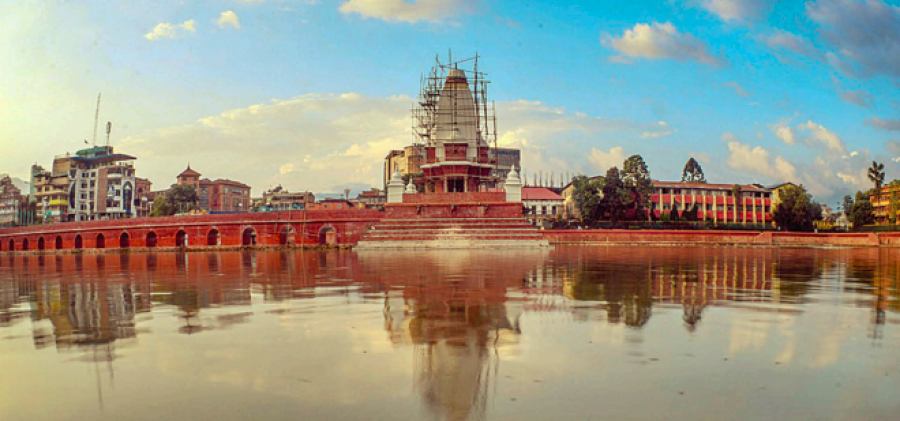Valley
Rani Pokhari regains its lost glory nearly after half a decade, but there is question regarding its sustainable preservation
Heritage lovers say the national rebuilding body did not make an outlet system in the pond and they are not sure if Kathmandu city office can preserve the site for posterity.
Anup Ojha
The historic Rani Pokhari, which wore a derelict look for over five years, finally looks like its former self.
The iconic landmark of Kathmandu, which was ravaged by the earthquake of 2015, is close to being restored.
Only a few finishing touches left before it is handed over to Kathmandu Metropolitan City, an official at the National Reconstruction Authority said.
The iconic pond spread over 63 ropanis of land has been replenished with water brought from Bagmati river and harvested rainwater.
Similarly, the Balgopaleshwor temple, which is situated in the middle of the pond, has also been restored in its original form, in Shikhara style as King Pratap Malla had constructed in 1670 AD, before the temple’s roof was given a distinct dome shape during the Rana regime.
“The temple’s Gajur (pinnacle) should be fixed by Thursday. Apart from that, a few other works remain, such as installing lights and cleaning the area,” said Raju Man Manandhar, the person assigned by the authority to oversee the restoration project.
“Once the works are completed, the reconstruction authority will hand over the Rani Pokhari to the care of Kathmandu Metropolitan City.”
The Rani Pokhari restoration project has been a long drawn out undertaking, one marred by a series of controversies, failed starts and restarts. After more than five years, after a sustained campaign launched by heritage lovers, and after Rs 240 million later, restoration of the historic monument is finally getting completed.
Now that the National Reconstruction Authority is preparing to hand over the Rani Pokhari to the Kathmandu Metropolitan City, the heritage lovers and conservationists, who had campaigned tirelessly for the restoration of the pond and the temple in its original state, are not sure whether the city authority could preserve the place.
Their suspicion is born out of the handling of the Rani Pokhari restoration works by the city office in the initial days before the government decided to hand over the project to the national rebuilding authority.
The project not only experienced delays under the city’s supervision, it also ran afoul of the heritage lovers and conservationists for the use of modern construction materials for the restoration of the historic site. Activists had also condemned Kathmandu Mayor Bidya Sundar Shakya for his commercial plan for Rani Pokhari, which also happens to be a religious site for Hindus.
“The campaign launched by heritage lovers and conservationists have helped resurrect Rani Pokhari to its original state. If not for our constant vigilance and activism, Mayor Shakya would have turned Rani Pokhari into a swimming pool,”said Ganapati Lal Shrestha, one of the leading conservationists in the Rani Pokhari restoration campaign.
In 2017, when the Kathmandu Metropolitan City initiated the Rani Pokhari restoration project, it had commissioned the construction of a 10-feet high concrete retaining wall on the eastern side of the pond. The move was roundely condemned by various quarters and the city office was eventually forced to demolish the concrete wall.
The project fell into a series of delays, halts and restarts after that.
At one point, a group of activists even reached the office of Deputy Mayor Hari Prabha Khadgi and offered her the grass from the dry pond bed as a symbolic protest.
To draw the attention of the city office towards the sorry state of Rani Pokhari, students affiliated to the Nepali Congress’s Nepal Student Union also organised a football match at Rani Pokhari.
After continuous protests and controversies, the government on January 28, 2019 entrusted the National Reconstruction Authority with the task of restoring Rani Pokhari.
The authority’s work was not without controversy either.
In May this year, the authority had dug two deep boring wells to replenish the pond, only to later backtrack from the decision after widespread criticism from ground water experts and conservationists.
While the activists who campaigned for the restoration of Rani Pokhari are pleased to see Rani Pokhari in its old form, they at the same time are also worried about how the city office will go about conserving the site and keeping the pond water clean.
“The authority restored Rani Pokhari but it does not have any plan on how to clean the pond water, nor does the city office. How can we be sure that this heritage site will survive for posterity?” said Shrestha, the conservationist.
Another heritage conservationist, Alok Siddhi Tuladhar, blamed the national rebuilding body for not showing judgement and sensitivity required while restoring a culturally important site like Rani Pokhari.
“Every pond has to be cleaned after a certain span of time. The newly restored and replenished Rani Pokhari does not even have an outlet system to drain the water,” said Tuladhar. “Even the Department of Archaeology seemed to have missed the preservation and maintenance aspects of Rani Pokhari.”




 19.12°C Kathmandu
19.12°C Kathmandu.jpg)









%20(1).jpg&w=300&height=200)

